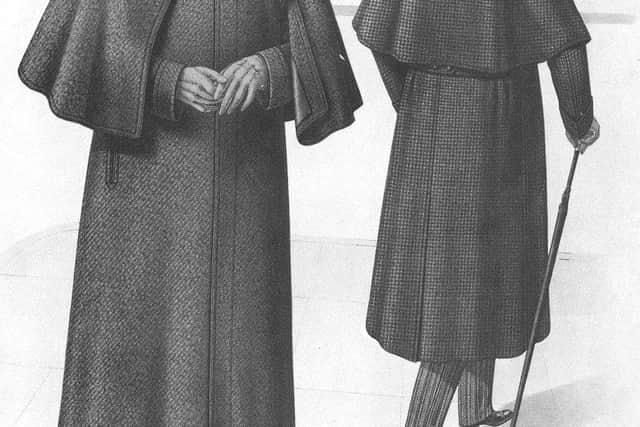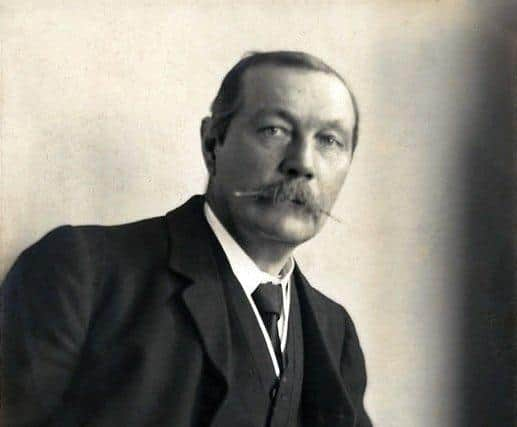Famous followers of fashion fancied their ‘plain and basic’ Ulster style


Few, excepting keen followers of fashion and fans of Sherlock Holmes books, will be over-familiar with the plain and basic ‘Ulster’.
But plain and basic it definitely wasn’t, or isn’t, as I’ve just discovered from a recent note in Roamer’s mailbox.
Advertisement
Hide AdAdvertisement
Hide Ad“The Ulster is a Victorian working daytime overcoat, with a cape and sleeves,” the e-mail began, referencing blogger Mark Thompson’s wonderful “Bloggin fae the & Burn: Ulster-Scots Thoughts.”


“Sherlock Holmes made it world famous but the Ulster overcoat was a Belfast invention,” Mark enthuses, thoroughly confirmed by an eminent local historian, the late Jack McCoy, in an enlightening article in the Irish Arts Review in 1985.
Describing the coat as a “tailoring phenomenon” that brought Northern Ireland’s clothing trade “unprecedented fame and reputation” McCoy quoted some of its accolades - “the best storm defier ever produced” which caused the word ‘Ulster’, according to one advertisement, to be “imported into every language in the civilised world.”
The ads weren’t exaggerating!
The coat was “exceedingly popular throughout the Empire and in America during the last two decades of Victoria’s reign and into the turn of the century,” Jack McCoy’s article continued, quoting from one of London’s top society magazines in 1897 - “no gentleman’s wardrobe is complete without an Ulster.”
Advertisement
Hide AdAdvertisement
Hide Ad

McCoy wrote about the coat’s many appearances “in films set in fog-bound London, usually muffling a waiting cab-driver or even decked betimes the shoulders of the great Holmes himself.”
Blogger Mark Thompson expands on the Ulster’s ubiquitous literary and big-screen manifestations.
“It is often seen in period productions of Victorian novels, such as those of Charles Dickens and Sir Arthur Conan Doyle.”
“The Ulster coat was referred to in Doyle’s Sherlock Holmes stories ‘A Study in Scarlet’, ‘The Sign of the Four’, ‘A Scandal in Bohemia’, ‘The Adventure of the Blue Carbuncle’ and ‘The Adventure of the Noble Bachelor.’”
Advertisement
Hide AdAdvertisement
Hide Ad

In the Blue Carbuncle Dr Watson recounted facing the winter weather with Holmes - “It was a bitter night so we drew on our Ulsters and wrapped cravats about our throats.”
There’s an authoritative description of the coat in The Complete Costume Dictionary, compiled by Elizabeth J. Lewandowski.
Dating its peak popularity between 1865 and1890 Lewandowski describes the Ulster as “a man’s single- or double-breasted overcoat with a waist belt.”
According to the Costume Dictionary the Ulster initially had a hood which was removed, or became detachable, by the 1870s.
Advertisement
Hide AdAdvertisement
Hide Ad“In 1875 a ticket pocket was added on the left sleeve above the cuff,” Lewandowski continues, and sometime after 1877 a woman’s version was introduced that was “long, sometimes trained (trailing) and similar to the men’s version.”
A lightweight version was known as the Ulsterette.
“The coat was designed, introduced and sold world-wide by McGee and Co., of 30-34 High Street, Belfast” historian Jack McCoy wrote in his 1985 Irish Arts Review.
The firm was established in 1842 by Antrim-born John Getty McGee, whose burgeoning commercial success soon afforded him a luxurious villa in Holywood, County Down.
After designing, making and selling countless coats, suits and hats, all of them profitable, McGee hit the jackpot in 1866 with a “travelling wrap” - a bulky, three-quarter or full-length single or double-breasted, close-fitting coat fitted initially with a hood and then later with a shoulder cape.
Advertisement
Hide AdAdvertisement
Hide AdIt boasted lots of pockets, a sturdy belt and a little leather ticket pouch above the left cuff.
McGee named his new coat “the Ulster” and it caught on so quickly that he had to expand his High Street business, calling it the Ulster Coat Warehouse.
“Priced at three and a half guineas or five guineas with Windermere lining” explained Jack McCoy “it was obviously fashioned for the professional well-to-do.”
The Belfast company was more than keen to publicise the Ulster’s distinguished patrons.
Advertisement
Hide AdAdvertisement
Hide AdCork-born ‘Fire-King’ Captain E.M Shaw, later Sir Eyre Massey Shaw KCB, the first Chief Officer of the Metropolitan Fire Brigade (now the London Fire Brigade) loved his Ulster.
“Without exception, the best driving coat I ever possessed,” the Fire-King enthused in an advertisement “it is quite impervious to wind and rain.”
It was worn and commended by Sir Pierre Louis Napoleon Cavagnari KCB CSI, the Italian-British military administrator who was killed on a British mission to Kabul, Afghanistan, in 1879.
Preacher, author, evangelist and hymn-writer Rev Charles Haddon Spurgeon wore an Ulster and so did Prince Edward of Saxe-Weimar KP, GCB, GCH, GCVO, PC, British Army Commander-in-Chief in Ireland in 1885.
Advertisement
Hide AdAdvertisement
Hide AdHaving introduced a popular Ulster coat for women, John G McGee died at the age of 67 in December 1883 while sailing home from New York on a Cunard steamer.
“Noted for his involvement in civic and Church of Ireland affairs” wrote Jack McCoy, “he was one of Belfast’s most respected citizens.”
His eldest son James took the company to further successes at home and abroad, and to new premises in the Scottish Provident Buildings in the centre of Belfast.
And the Ulster became a fashion icon, worldwide.
More of its proud history, and its similar-looking Inverness coat, here next week.